
Days from now, the entire United States will see at least a partial eclipse of the sun. Parts of 11 states will be fortunate enough to see a total eclipse. What was once believed to be a sign of impending doom, eclipses are a just a light show straight from the heavens.
But before you make plans to enjoy the eclipse, there are a few things to remember to safeguard your vision.
NOVA | Watch An Eclipse Without Frying Your Eyeballs | PBS
Here's how you can safely watch the upcoming solar eclipse. For more, don't miss NOVA l PBS' Eclipse Over America, premiering Aug 21 at 9/8c. #EclipsePBS
Posted by PBS on Sunday, August 13, 2017
Where can you see it?
To see a total eclipse, where the moon fully covers the sun, on Monday, August 21, you will have to be in the path of totality, which is about 70 miles wide and will start in Lincoln Beach, Oregon and end near Charleston, South Carolina, according to NASA.
Several cities in north Georgia, including Blairsville and Blue Ridge, will see a total eclipse. Georgia Eye Specialists is fortunate enough to be located in Marietta, which will see a 97.4% eclipse with almost all of the sun covered by the moon. According to NASA, for viewers in the Marietta area, the eclipse will start at exactly 1:05 p.m., hit the maximum eclipse (its darkest point) at 2:36 p.m., and end 1 hour and 25 minutes later at 4:01 p.m.
Covering the 97.4% of the sun may turn day into night, but that 2.6% sliver you can see can still damage your eyes.
Do not look at the eclipse directly
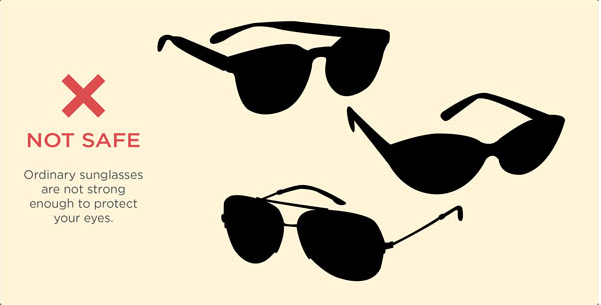
It is easy to forget just how bright the sun really is. The University of Colorado estimates that “the sun radiates more energy in one second than people have used since the beginning of time!”
Staring at even the smallest sliver of direct sunlight can damage the retina.
Dr. Tushar Suthar, a retina specialist at Georgia Eye Specialists, says “Looking at the eclipse can lead to damage in the retina and cause a condition known as Solar Retinopathy. This happens when the photoreceptors in the retina are damaged by the sun’s rays. Unfortunately, there is no treatment for this condition so the only thing we can do is prevent the damage from occurring in the first place.”
Russell Van Gelder, MD, former president of the American Academy of Ophthalmology explains “The eye is actually a magnifier, and it is about 3 or 4 times stronger than most hand-held magnifying glasses,” Van Gelder says. If even a weak magnifying glass can focus enough light to set paper on fire, imagine what it can do your retina.And you may not even feel it. “There are no pain fibers in the eye, so people don’t know they’re injuring their eye,” Van Gelder says.
Only view the eclipse through special-purpose solar filters or viewers
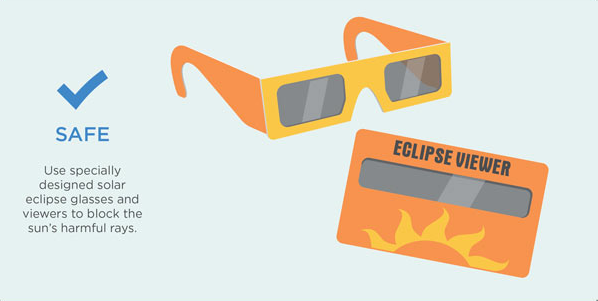
Since it is hard to know exactly when to stop looking at the total eclipse, the only truly safe way to look directly at the sun, whether during an eclipse or not, is through special-purpose solar filters. “Eclipse glasses” and in hand-held solar viewers use these solar filters to reduce the intensity of the sun so that the retina is not damaged. Because of the potential to cause lasting damage to people’s vision, these filters must meet a strict worldwide standard identified as ISO 12312-2. Unfortunately, the market has seen counterfeit glasses that advertise the same ISO number that are not compliant so the American Academy of Academy of Ophthalmology recommends four manufacturers have certified that their eclipse glasses have met the standards for eye protection:
How can you tell if your solar viewer is safe?
According the American Astronomical Society (AAS), “You shouldn’t be able to see anything through a safe solar filter except the sun or something comparably bright, such as the sun reflected in a mirror.” If you can see other lights through your eclipse glasses or handheld viewer and you’re not sure the product came from a reputable vendor, it’s no good advises AAS Press Officer Rick Fienberg.
AAS also advises the public to not purchase eclipse glasses found by searching on the internet or clicking on ads. Not only could you lose your money, you could also lose your sight. AAS also maintain a list of reputable vendors that you can buy one from.
https://eclipse.aas.org/resources/solar-filters
Caution: Do not use any glasses or filters if they are damaged, scratched or old.
While they may protect most of your retina, you can still damage the part of the retina not protected by the damaged or compromised portion of the filter.
https://www.aao.org/eye-health/tips-prevention/where-to-get-solar-eclipse-glasses-updated-advice
Just like ordinary sunglasses, even very dark ones, homemade filters are not safe for looking at the sun either.
If you don’t have special glasses, create a pinhole projector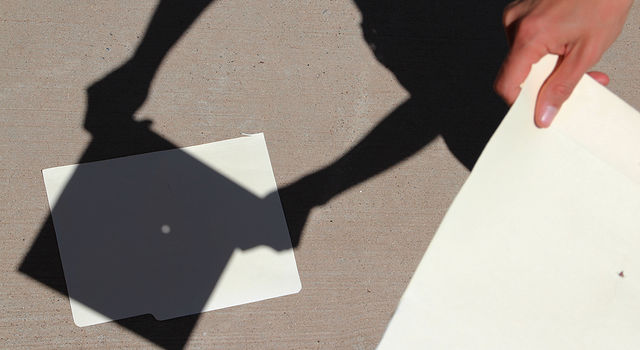
Another way to see the eclipse is through a pinhole projection. A pinhole viewer lets you project an image of the sun onto another surface, like paper, a wall or pavement. The image of the sun is safe to look at throughout the eclipse.
It can be as simple to make as poking a small hole in a piece of paper or a box so that you can view a projected image of the eclipse on a white piece of paper.
https://www.jpl.nasa.gov/edu/learn/project/how-to-make-a-pinhole-camera/
Do not use cameras, binoculars or telescopes to view the eclipse
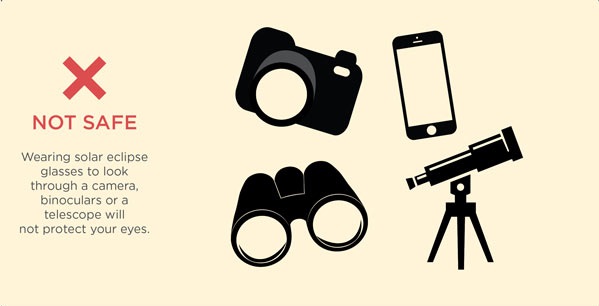 Cameras, binoculars, telescopes and even cellphones are NOT safe viewers if you are not using the right kind of filters or lenses. The eclipse glasses are designed for natural viewing with the naked eye. Any lens that magnifies the eclipse can overpower the filter and allow damaging rays to enter the eye. Even framing and focusing the picture can be a problem if you have to look though a view finder that isn’t also properly protected.
Cameras, binoculars, telescopes and even cellphones are NOT safe viewers if you are not using the right kind of filters or lenses. The eclipse glasses are designed for natural viewing with the naked eye. Any lens that magnifies the eclipse can overpower the filter and allow damaging rays to enter the eye. Even framing and focusing the picture can be a problem if you have to look though a view finder that isn’t also properly protected.
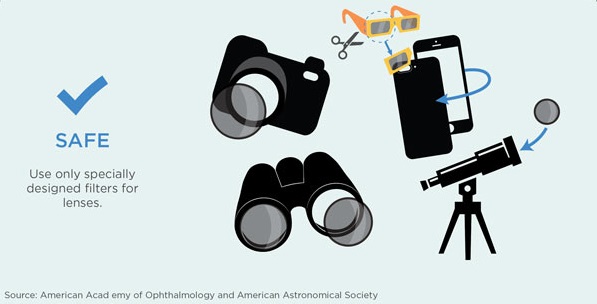 The American Astronomical Society has resources on its website that describe how to use these devices safely, including tips for how to shoot still images or video of a solar eclipse.
The American Astronomical Society has resources on its website that describe how to use these devices safely, including tips for how to shoot still images or video of a solar eclipse.
https://eclipse2017.nasa.gov/sites/default/files/Photographing%20the%20Eclipse%20with%20your%20Smartphone.pdf
You can also view the eclipse online
Consider watching online or find an event at a local planetarium, science center or club where you know the right safety measures have been taken.
NASA will live stream the eclipse and, as a bonus, NASA offers safe ways to view the eclipse from airplanes, balloons, high powered telescopes and other locations.
Click here https://eclipse2017.nasa.gov/eclipse-live-stream
You can even contribute to science
Google has teamed up with the University of California, Berkeley and a huge army of citizen scientists to create a Megamovie to document the eclipse from various vantage points.
Join the effort by contributing your video of the eclipse at https://eclipsemega.movie/
For many, this might be a once in a lifetime event to share with family and friends. We, at Georgia Eye Specialists, want you to enjoy seeing this event and many others, for years to come.